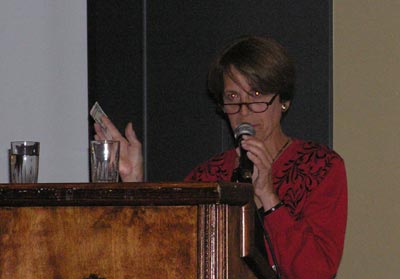There were a lot of good presentations Friday at the Space Access ’06 conference in Phoenix, although not necessarily a lot of breaking news. Given limited time (plus the fact that the wireless network in the conference room was down most of the day) I’ll for the moment provide some brief highlights:
Rick Homans, secretary of the Economic Development Department of the state of New Mexico, said he had no involvement in the space industry prior to taking office in January 2003; shortly after taking office he was briefed on the state’s Office of Space Commercialization and spaceport plans. He said the state decided to put in a “very aggressive bid” when they received the RFP for the X Prize Cup, recognizing it as their best and perhaps only shot to develop the spaceport. That eventually led to winning $114 million in state funding earlier this year for the spaceport, although most of that funding, he said, is conditioned on receiving an FAA spaceport license, signing a lease with an anchor tenant (Virgin Galactic), and a bona fide cost estimate for the spaceport that demonstrates it will cost no more than $225 million to build. He said the state expects the FAA license by the end of 2006 or the first quarter of 2007.
[Disclosure: my employer performed an economic impact study about the proposed spaceport for the Economic Development Department.]
John Carmack of Armadillo Aerospace provided an update on his efforts, emphasizing, as usual, the various technical accomplishments and plans of his team. Armadillo is now focusing on building a pair of VTVL vehicles to compete for the two levels of Lunar Lander Challenge planned for October at the X Prize Cup. The larger vehicle, designed for level 2 (180 seconds of flight time) would also be able to carry cargo or passengers to 100 kilometers; he said there is “a real possibility” of flying that vehicle to 100 km by the end of the year, although through October Armadillo will be focused on the challenge. The launch site for those flights remains to be determined: New Mexico is a backup site, although farther away than Carmack likes. They hope instead to be able to fly from private land in Texas. All this is being done on a tiny budget: Carmack said his burn rate is less than half a million dollars a year.
Chuck Lauer of Rocketplane Kistler discussed the efforts of both Rocketplane and Kistler Aerospace, which Rocketplane’s president, George French, acquired earlier this year. Rocketplane’s development appears to be on schedule: one wing, a structural test article, is nearly complete and will soon be tested to destruction. Engine tests using the RS-88 engine being loaned from NASA will begin this summer. Rocketplane Kistler submitted a COTS proposal to NASA to accelerate development of the long-stalled K-1 TSTO RLV: if they win it, Lauer said the K-1 could be ready to fly in 2008. Even without COTS, Lauer said, they still plan to raise private funding to develop the K-1, with a focus on several markets, including orbital space tourism: the K-1 could carry 5-6 people, he said.
Jeff Greason of XCOR Aerospace said his company’s fortunes are looking good. The company booked $1.1 million in revenue in 2005 and will earn $3.5 million in 2006 under its current contracts alone. XCOR now has 25 employees and is looking to hire several more, including engineers and project managers, by the end of the year. (One of those new employees is reportedly Henry Vanderbilt, who announced earlier this year he was going to work for an unnamed company in this industry.) While XCOR is focusing most of its efforts on several projects, like the X-Racer and LOX tank development, he said that a couple of people in the company are still focused on developing a suborbital vehicle. XCOR still does not have full funding for the vehicle, but has raised more than half.
Reda Anderson, the first customer for Rocketplane Kistler’s XP spaceplane, talked about what was important to her as a customer. (She doesn’t like the term “space tourist”, preferring something like “explorer”.) Safety, communications, integrity, and catering to the passenger’s friends and family are all key things she looks for in a company providing tourism services, she said. She also showed off the “contract” she made with Lauer in October 2004: a dollar bill wrapped around a business card:

Perhaps the coolest item of the day was a presentation by Timothy Bendel of Frontier Astronautics. His small company, which is developing an attitude control system for Masten Space Systems as well as a rocket engine, needed to find a new place for its engine development work since local authorities in Colorado blocked such work. They found an ideal location in the small town of Chugwater, Wyoming, north of Cheyenne: a facility complete with machine shop, three phase power, huge concrete facilities, and lots of land, with paved access to I-25. What is it? An abandoned Atlas-E ICBM site. Bendel said he plans to lease the site to other companies seeking such facilities, and is also looking into using the site as a spaceport.

[…] John Gedmark of the X Prize Foundation talked about the upcoming X Prize Cup 2006 in October in Las Cruces, NM. The event will feature NASA’s Lunar Lander Challenge for developers of vehicles that can vertically take off, hover, translate, and land. (See yesterday’s post about Armadillo’s plans for the competition.) The exact rules and even prize amounts are in flux, and Gedmark would only say that a final announcement would be made about the competition “soon”. The XP Cup will also be the home of the Reusable Rocket challenge, for launching, recovering, and reusing sounding rockets or VTVL vehicles. Rules for that competition are still under development. […]